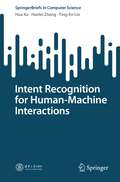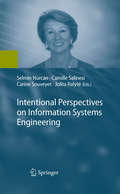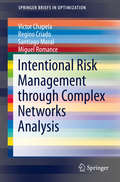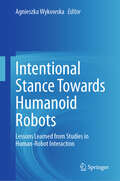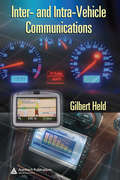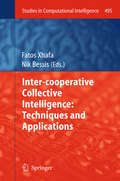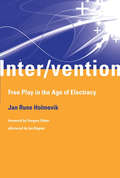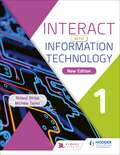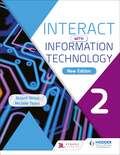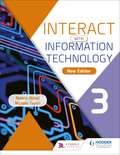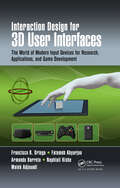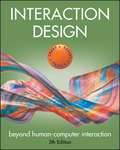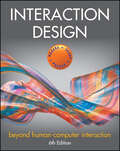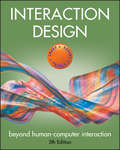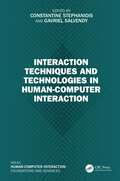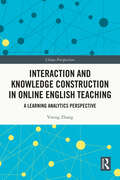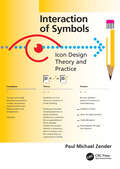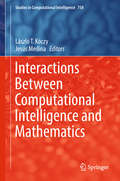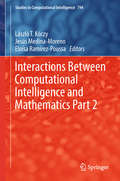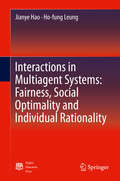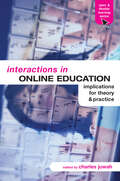- Table View
- List View
Intent Recognition for Human-Machine Interactions (SpringerBriefs in Computer Science)
by Hua Xu Hanlei Zhang Ting-En LinNatural interaction is one of the hottest research issues in human-computer interaction. At present, there is an urgent need for intelligent devices (service robots, virtual humans, etc.) to be able to understand intentions in an interactive dialogue. Focusing on human-computer understanding based on deep learning methods, the book systematically introduces readers to intention recognition, unknown intention detection, and new intention discovery in human-computer dialogue. This book is the first to present interactive dialogue intention analysis in the context of natural interaction. In addition to helping readers master the key technologies and concepts of human-machine dialogue intention analysis and catch up on the latest advances, it includes valuable references for further research.
Intentional Perspectives on Information Systems Engineering
by Selmin Nurcan Jolita Ralyté Carine Souveyet Camille SalinesiRequirements engineering has since long acknowledged the importance of the notion that system requirements are stakeholder goals--rather than system functions--and ought to be elicited, modeled and analyzed accordingly. In this book, Nurcan and her co-editors collected twenty contributions from leading researchers in requirements engineering with the intention to comprehensively present an overview of the different perspectives that exist today, in 2010, on the concept of intention in the information systems community. These original papers honor Colette Rolland for her contributions to this field, as she was probably the first to emphasize that 'intention' has to be considered as a first-class concept in information systems engineering. Written by long-term collaborators (and most often friends) of Colette Rolland, this volume covers topics like goal-oriented requirements engineering, model-driven development, method engineering, and enterprise modeling. As such, it is a tour d'horizon of Colette Rolland's lifework, and is presented to her on the occasion of her retirement at CaISE 2010 in Hammamet, the conference she once cofounded and which she helped to grow and prosper for more than 20 years.
Intentional Risk Management through Complex Networks Analysis
by Victor Chapela Regino Criado Santiago Moral Miguel RomanceThis book combines game theory and complex networks to examine intentional technological risk through modeling. As information security risks are in constant evolution, the methodologies and tools to manage them must evolve to an ever-changing environment. A formal global methodology is explained in this book, which is able to analyze risks in cyber security based on complex network models and ideas extracted from the Nash equilibrium. A risk management methodology for IT critical infrastructures is introduced which provides guidance and analysis on decision making models and real situations. This model manages the risk of succumbing to a digital attack and assesses an attack from the following three variables: income obtained, expense needed to carry out an attack, and the potential consequences for an attack. Graduate students and researchers interested in cyber security, complex network applications and intentional risk will find this book useful as it is filled with a number of models, methodologies and innovative examples.
Intentional Stance Towards Humanoid Robots: Lessons Learned from Studies in Human-Robot Interaction
by Agnieszka WykowskaWith the reinassance of Artificial Intelligence (AI) and AI-empowered technologies, such as robots, we are all asking ourselves the question: What role will these new technologies play in our lives and in our society? On the one hand, we are excited about the new opportunities that AI and robots bring. On the other hand, there are understandable fears: What if the AI becomes too powerful? What if the robots become too human-like? This book is centered around a theoretical framework of the Intentional Stance, initially proposed by Daniel Dennett, and addresses the timely question: How do we, humans, approach robots? Do we see them as intentional agents that can potentially become our social companions? Or do we rather approach them as tools, man-made artifacts? What does it take for a robot to make an impression that it is an intentional/social agent? Is it its appearance? Its behaviour? Or, perhaps (and quite likely), the way it interacts with the human? These questions are addressed across various chapters of book, each of which is then complemented by an inspiring conversation with one of the prominent academics and scholars: Daniel Dennett (Philosophy) – the originator of the concept of the Intentional Stance; Hiroshi Ishiguro (Robotics) – the creator of androids, David Gunkel (Robot-Ethics), Bertram Malle (Cognitive Science), Antonio Sgorbissa (Culturally-competent Social Robotics), Bill Vorn (Robotic Art). The book discusses also some important ethical considerations to be made, and risks to be aware of. Do we actually want to create robots that are treated as intentional agents? What if the line between the human/robot categories becomes blurred? As intentional agents, should robots become also moral agents and legal persons in our societal and legal systems?
Inter- and Intra-Vehicle Communications
by Gilbert HeldThe PC revolution, the advent of PDAs, and growth in the use of wireless LANs have changed the way we live our lives. Next on the horizon is the application of new technologies that will change the way we drive our cars. De rigeur for many drivers, electronic passes and GPS systems represent the tip of the iceberg in terms of emerging applications
Inter-cooperative Collective Intelligence: Techniques and Applications
by Fatos Xhafa Nik BessisThis book covers the latest advances in the rapid growing field of inter-cooperative collective intelligence aiming the integration and cooperation of various computational resources, networks and intelligent processing paradigms to collectively build intelligence and advanced decision support and interfaces for end-users. The book brings a comprehensive view of the state-of-the-art in the field of integration of sensor networks, IoT and Cloud computing, massive and intelligent querying and processing of data. As a result, the book presents lessons learned so far and identifies new research issues, challenges and opportunities for further research and development agendas. Emerging areas of applications are also identified and usefulness of inter-cooperative collective intelligence is envisaged. Researchers, software developers, practitioners and students interested in the field of inter-cooperative collective intelligence will find the comprehensive coverage of this book useful for their research, academic, development and practice activity.
Inter/vention
by Jan Rune Jan Rune HolmevikIn today's complex digital world, we must understand new media expressions and digital experiences not simply as more technologically advanced forms of "writing" that can be understood and analyzed as "texts" but as artifacts in their own right that require a unique skill set. Just as agents seeking to express themselves in alphabetic writing need to be literate, "egents" who seek to express themselves in digital media need to be--to use a term coined by cybertheorist Gregory Ulmer-- electrate. In Inter/vention, Jan Holmevik helps to invent electracy. He does so by tracing its path across the digital and rhetorical landscape--informatics, hacker heuretics, ethics, pedagogy, virtual space, and monumentality--and by introducing play as a new genre of electracy. Play, he argues, is the electrate ludic transversal. Holmevik contributes to the repertoire of electrate practices in order to understand and demonstrate how play invents electracy. Holmevik's argument straddles two divergences: in rhetoric, between how we study rhetoric as play and how we play rhetorically; and in game studies, between ludology and narratology. Games studies has forged ludology practice by distinguishing it from literate practice (and often allying itself with the scientific tradition). Holmevik is able to link ludology and rhetoric through electracy. Play can and does facilitate invention: play invented the field of ludology. Holmevik proposes a new heuretic in which play acts as a conductor for the invention of electracy. Play is a meta behavior that touches on every aspect of Ulmer's concept of electracy.
Inter/vention: Free Play in the Age of Electracy
by Jan Rune HolmevikA proposal that electracy—the special skills needed to navigate and understand our digital world—can be developed through play. In today's complex digital world, we must understand new media expressions and digital experiences not simply as more technologically advanced forms of “writing” that can be understood and analyzed as “texts” but as artifacts in their own right that require a unique skill set. Just as agents seeking to express themselves in alphabetic writing need to be literate, “egents” who seek to express themselves in digital media need to be—to use a term coined by cybertheorist Gregory Ulmer—electrate. In Inter/vention, Jan Holmevik helps to invent electracy. He does so by tracing its path across the digital and rhetorical landscape—informatics, hacker heuretics, ethics, pedagogy, virtual space, and monumentality—and by introducing play as a new genre of electracy. Play, he argues, is the electrate ludic transversal. Holmevik contributes to the repertoire of electrate practices in order to understand and demonstrate how play invents electracy.Holmevik's argument straddles two divergences: in rhetoric, between how we study rhetoric as play and how we play rhetorically; and in game studies, between ludology and narratology. Games studies has forged ludology practice by distinguishing it from literate practice (and often allying itself with the scientific tradition). Holmevik is able to link ludology and rhetoric through electracy.Play can and does facilitate invention: play invented the field of ludology. Holmevik proposes a new heuretic in which play acts as a conductor for the invention of electracy. Play is a meta behavior that touches on every aspect of Ulmer's concept of electracy.
Interact with Information Technology 1 new edition
by Michele Taylor Roland BirbalProvide an accessible approach to theory and practice with this new edition updated to comprehensively cover recent IT developments and the latest Caribbean curricula for Forms 1 to 3 (Grades 7 to 9).- Consolidate learning through a range of question types such as Multiple Choice, True or False, Short Answer and a fun Crossword puzzle.- Build critical thinking and project work skills with research and STEM projects using real life situations.- Develop understanding with new topics covered such as computer ethics, algorithm development, emerging careers.The answers can be found here: www.hoddereducation.co.uk/interactanswers
Interact with Information Technology 2 new edition
by Michele Taylor Roland BirbalProvide an accessible approach to theory and practice with this new edition updated to comprehensively cover recent IT developments and the latest Caribbean curricula for Forms 1 to 3 (Grades 7 to 9).- Consolidate learning through a range of question types such as Multiple Choice, True or False, Short Answer and a fun Crossword puzzle.- Build critical thinking and project work skills with research and STEM projects using real life situations.- Develop understanding with new topics covered such as computer ethics, algorithm development, emerging careers.The answers can be found here: www.hoddereducation.co.uk/interactanswers
Interact with Information Technology 3 new edition
by Michele Taylor Roland BirbalProvide an accessible approach to theory and practice with this new edition updated to comprehensively cover recent IT developments and the latest Caribbean curricula for Forms 1 to 3 (Grades 7 to 9).- Consolidate learning through a range of question types such as Multiple Choice, True or False, Short Answer and a fun Crossword puzzle.- Build critical thinking and project work skills with research and STEM projects using real life situations.- Develop understanding with new topics covered such as computer ethics, algorithm development, emerging careers.The answers can be found here: www.hoddereducation.co.uk/interactanswers
Interacting Complexities of Herds and Social Organizations: Agent Based Modeling (Evolutionary Economics and Social Complexity Science #19)
by Stanislaw RaczynskiThis book presents examples of and the latest simulation studies on artificial societies and populations, highlighting innovative implementations of various models of artificial societies and populations using a new, C++-related simulation tool. It demonstrates that the prey-predator models—including spatial distribution, moving patterns, limited renewable food, fear, gregarious (herd) instinct, clustering, epidemics, and competition—are more complex than other publications have suggested, and highlights the great discrepancy between agent-based and conventional continuous models. The book also discusses the modeling and simulation of self-organization and interactions between organizations, including terror organizations, offering fascinating insights into organizational dynamics. The book provides a broad range of examples and comparisons with the classical dynamics approach, showing readers how to construct models of complex systems. It starts with descriptions of the behavior of interacting individuals and also includes important information on the macro-behavior of the whole system.
Interaction Design for 3D User Interfaces: The World of Modern Input Devices for Research, Applications, and Game Development
by Francisco R. Ortega Fatemeh Abyarjoo Armando Barreto Naphtali Rishe Malek AdjouadiThis book addresses the new interaction modalities that are becoming possible with new devices by looking at user interfaces from an input perspective. It deals with modern input devices and user interaction and design covering in-depth theory, advanced topics for noise reduction using Kalman Filters, a case study, and multiple chapters showing hands-on approaches to relevant technology, including modern devices such as the Leap-Motion, Xbox One Kinect, inertial measurement units, and multi-touch technology. It also discusses theories behind interaction and navigation, past and current techniques, and practical topics about input devices.
Interaction Design: Beyond Human-Computer Interaction
by Helen Sharp Jenny Preece Yvonne Rogers Jennifer PreeceHugely popular with students and professionals alike, the Fifth Edition of Interaction Design is an ideal resource for learning the interdisciplinary skills needed for interaction design, human-computer interaction, information design, web design, and ubiquitous computing. New to the fifth edition: a chapter on data at scale, which covers developments in the emerging fields of 'human data interaction' and data analytics. The chapter demonstrates the many ways organizations manipulate, analyze, and act upon the masses of data being collected with regards to human digital and physical behaviors, the environment, and society at large. <p><p> Revised and updated throughout, this edition offers a cross-disciplinary, practical, and process-oriented, state-of-the-art introduction to the field, showing not just what principles ought to apply to interaction design, but crucially how they can be applied.
Interaction Design: Beyond Human-Computer Interaction
by Helen Sharp Yvonne Rogers Jennifer PreeceA delightful, engaging, and comprehensive overview of interaction design Effective and engaging design is a critical component of any digital product, from virtual reality software to chatbots, smartphone apps, and more. In the newly updated sixth edition of Interaction Design: Beyond Human-Computer Interaction, a team of accomplished technology, design, and computing professors delivers an intuitive and instructive discussion of the principles underlying the design of effective interactive technologies. The authors discuss how to design and apply digital technologies in the real world, illustrated with numerous examples. The book explores the interdisciplinary foundations of interaction design, including skills from product design, computer science, human and social psychology, and others. The book builds on the highly successful fifth edition and draws on extensive new research and interviews with accomplished professionals and researchers in the field that reflect a rapidly-changing landscape. It is supported by a website hosting digital resources that add to and complement the material contained within. Readers will also find: Explorations of the social and emotional components of interacting with apps, digital devices and computers Descriptions about how to design, prototype, evaluate and construct technologies that support human-computer interaction Discussions of the cognitive aspects of interaction design, as well as design and evaluation, including usability testing and expert reviews. An essential text for undergraduate and graduate students of human-computer interaction, interaction design, software engineering, web design, and information studies, Interaction Design will also prove to be indispensable for interaction design and user experience professionals.
Interaction Design: Beyond Human-Computer Interaction (Ics Ser.)
by Helen Sharp Yvonne Rogers Jennifer PreeceA new edition of the #1 text in the human computer Interaction field! Hugely popular with students and professionals alike, the Fifth Edition of Interaction Design is an ideal resource for learning the interdisciplinary skills needed for interaction design, human-computer interaction, information design, web design, and ubiquitous computing. New to the fifth edition: a chapter on data at scale, which covers developments in the emerging fields of 'human data interaction' and data analytics. The chapter demonstrates the many ways organizations manipulate, analyze, and act upon the masses of data being collected with regards to human digital and physical behaviors, the environment, and society at large. Revised and updated throughout, this edition offers a cross-disciplinary, practical, and process-oriented, state-of-the-art introduction to the field, showing not just what principles ought to apply to interaction design, but crucially how they can be applied. Explains how to use design and evaluation techniques for developing successful interactive technologies Demonstrates, through many examples, the cognitive, social and affective issues that underpin the design of these technologies Provides thought-provoking design dilemmas and interviews with expert designers and researchers Uses a strong pedagogical format to foster understanding and enjoyment An accompanying website contains extensive additional teaching and learning material including slides for each chapter, comments on chapter activities, and a number of in-depth case studies written by researchers and designers.
Interaction Techniques and Technologies in Human-Computer Interaction
by Gavriel Salvendy Constantine StephanidisThis book offers a thorough exploration of interaction design by examining various technologies,interaction techniques, styles, and devices.This book• Assists readers in acquiring a deep understanding of diverse ways humans interact withcomputer technologies and in selecting the most suitable approach for various interactivescenarios.• Introduces cutting‑edge interaction techniques, including multimodal and gesture‑basedinteraction, wearables, haptic, speech and sound‑based interaction, embodied interaction,and more.• Advances beyond traditional interfaces to large and multiscreen interactions, proxemics,brain‑computer interfaces, affective computing and Extended Reality.This book will appeal to individuals interested in Human-Computer Interaction research andapplications.
Interaction and Knowledge Construction in Online English Teaching: A Learning Analytics Perspective (China Perspectives)
by Yining ZhangWithin a Chinese English as a Foreign Language (EFL) learning context, this book investigates how teachers and learners interacted and articulated their understanding of English for Research Publication Purposes (ERPP)-related knowledge in a synchronous EFL classroom.The outbreak of the COVID-19 Pandemic changed the way people receive education, causing an almost overnight switch from on-campus instruction to distance learning. Under the use of three different learning analytics approaches, this book has moved beyond the usual descriptive understanding of the online learning process to an in-depth exploratory and inferential analysis of the entities, structures, relations, and processes of learning. The findings enrich current understandings of the complexity of ERPP teaching and learning in synchronous learning contexts. These findings also drive us to rethink and reshape the way ERPP instruction is delivered post-pandemic. An essential read for students and scholars of education and academic English. This book will also be a vital source for researchers in the field of learning analytics, data analysis, and data interpretation in language teaching and learning.
Interaction and Knowledge Construction in Online English Teaching: A Learning Analytics Perspective (ISSN)
by Yining ZhangWithin a Chinese English as a Foreign Language (EFL) learning context, this book investigates how teachers and learners interacted and articulated their understanding of English for Research Publication Purposes (ERPP)-related knowledge in a synchronous EFL classroom.The outbreak of the COVID-19 pandemic changed the way people receive education, causing an almost overnight switch from on-campus instruction to distance learning. Under the use of three different learning analytics approaches, this book has moved beyond the usual descriptive understanding of the online learning process to an in-depth exploratory and inferential analysis of the entities, structures, relations, and processes of learning. The findings enrich current understandings of the complexity of ERPP teaching and learning in synchronous learning contexts. These findings also drive us to rethink and reshape the way ERPP instruction is delivered post-pandemic.An essential read for students and scholars of education and academic English. This book will also be a vital source for researchers in the field of learning analytics, data analysis, and data interpretation in language teaching and learning.
Interaction for Designers: How To Make Things People Love
by Brian L.M BoylInteraction for Designers shows you how to connect a product with its users, whether it’s a simple toaster, a complex ecosystem of intelligent devices, or a single app on your smartphone. This book covers the entire design process so you can start with an idea and carry it through to an engaging final design. It carefully leads you step by step and richly illustrates each stage with examples drawn from business communication, social media and the social economy, consumer electronics, architecture and environments, health care, psychology, art and culture, education, athletics, automotive design, entertainment, fashion, the family home, and a wealth of others. You’ll learn how to brainstorm ideas, research them, explore them, evolve them into finished designs, pitch them, all with the goal of helping you make things that people love. Includes over 200 color images, a glossary, and links to web resources highlighting design concepts and designer interviews. http://interactionfordesigners.com/
Interaction of Symbols: Icon Design Theory and Practice
by Mike ZenderInteraction of Symbols is a book for everyone engaged with icon design. It presents a theory of how icons work: symbols in an icon interact to evoke meaning. From this theory flow design principles and practices based on evidence from Design and other disciplines such as Psychology, Perception, and Cognition. The theory, principles, and practices impact how all symbol-based communications are conceived, designed, and applied.The book focuses on icons that elicit a concept without any previous training or use of language. Findings from twenty years’ worth of empirical design research studies explore, illustrate, and support each principle, process, and recommendation. The book begins with a review of icon research from various fields before laying a conceptual foundation that grounds the theory of the book. After and elaborating on that theory are chapters that demonstrate how to Establish Contexts to Guide Comprehension, Glean Which Symbols to Draw, Learn How to Draw Understandable Symbols, Clarify Metaphor, and Use Icons to Decipher Icons in Icon Systems. Written and carefully designed for a broad audience, the book’s scholarly level is elevated while the presentation is approachable. Scholar or professional can skim, scan, or dig, it’s up to them.Heavily illustrated and supported with ample citations, it is not only a book for students and professionals within the field of communication design, but also for anyone who communicates with visual symbols, from healthcare professionals to software engineers, affecting all kinds of graphic communications from advertisements to assembly instructions.
Interactions Between Computational Intelligence and Mathematics (Studies in Computational Intelligence #758)
by László T. Kóczy Jesús MedinaThis book presents recent research in the field of interaction between computational intelligence and mathematics, ranging from theory to applications. Computational intelligence, or soft computing consists of various bio-inspired methods, especially fuzzy systems, artificial neural networks, evolutionary and memetic algorithms. These research areas were initiated by professionals in various applied fields, such as engineers, economists, and financial and medical experts. Although computational intelligence offered solutions (at least quasi-optimal solutions) for problems with high complexity, vague and undeterministic features, initially little attention was paid to the mathematical models and analysis of the methods successfully applied. A typical example is the extremely successful Mamdani-algorithm, and its modifications and extensions, applied since the mid-1970s, where the first analysis of the simplest cases, showing why this algorithm was so efficient and stable, was not given until the early 1990s.Since the mid-2000s, the authors have organized international conferences annually to focus on the mathematical methodological issues in connection with computational intelligence approaches. These conferences have attracted a large number of submissions with a wide scope of topics and quality. The editors selected several high-quality papers and approached the authors to submit an essentially extended and improved book chapter based on the lectures.This volume is the first contributed book on the subject.
Interactions Between Computational Intelligence and Mathematics Part 2
by László T. Kóczy Jesús Medina-Moreno Eloísa Ramírez-PoussaThis book presents recent research in the field of interaction between computational intelligence and mathematics. In the current technological age, we face the challenges of tackling very complex problems – in the usual sense, but also in the mathematical and theoretical computer science sense. However, even the most up-to-date results in mathematics, are unable to provide exact solutions of such problems, and no further technical advances will ever make it possible to find general and exact solutions. Constantly developing technologies (including social technologies) necessitate handling very complex problems. This has led to a search for acceptably “good” or precise solutions, which can be achieved by the combination of traditional mathematical techniques and computational intelligence tools, in order to solve the various problems emerging in many different areas to a satisfactory degree. Important funding programs, such as the European Commission’s current framework programme for research and innovation – Horizon 2020 – are devoted to the development of new instruments to deal with the current challenges. Without doubt, research topics associated with the interactions between computational intelligence and traditional mathematics play a key role. Presenting contributions from engineers, scientists and mathematicians, this book offers a series of novel solutions for meaningful and real-world problems that connect those research areas.
Interactions in Multiagent Systems: Fairness, Social Optimality and Individual Rationality
by Jianye Hao Ho-Fung LeungThisbook mainly aims at solving the problems in both cooperative and competitivemulti-agent systems (MASs), exploring aspects such as how agents caneffectively learn to achieve the shared optimal solution based on their localinformation and how they can learn to increase their individual utility byexploiting the weakness of their opponents. The book describes fundamental andadvanced techniques of how multi-agent systems can be engineered towards thegoal of ensuring fairness, social optimality, and individual rationality; awide range of further relevant topics are also covered both theoretically andexperimentally. The book will be beneficial to researchers in the fields ofmulti-agent systems, game theory and artificial intelligence in general, as wellas practitioners developing practical multi-agent systems.
Interactions in Online Education: Implications for Theory and Practice (Open and Flexible Learning Series)
by Charles JuwahInteractivity is at the very heart of learning and is evident at all levels of engagement, whether between fellow students, students and tutors, online learning materials or interfacing with the learning environment. Covering both theory and the practical implications of the issues discussed, this book provides international perspectives on key topics including: analysing and designing e-learning interactions, social and conceptual dimensions of learning, interactions in online discussions, interactions in peer learning and professional development of online facilitators. It is essential reading for all those involved in the design, implementation, management and use of open and flexible learning.
